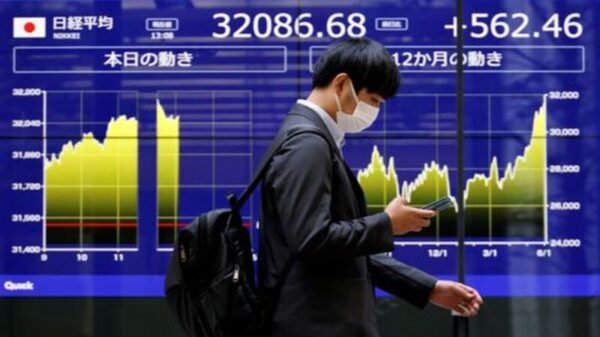Asian equities slumped on Thursday after global central banks underlined their ambition to battle inflation, warning rates may need to rise higher. The yen and yuan failed to recover from lows over intervention fears.
EURO STOXX 50 and FTSE futures are down 0.1%, indicating a weaker European open. Wall Street futures rose 0.1% ahead of Friday’s U.S. PCE data.
MSCI’s broadest index of Asia-Pacific equities outside Japan (.MIAPJ0000PUS) was down 0.5% due to holidays in Singapore, India, and Malaysia.
The Hang Seng index (.HSI) plummeted 1.3% while Chinese blue chips (.CSI300) dipped 0.3%. The Nikkei (.N225) lost 0.1% of its earlier gains.
The onshore yuan fell to 7.2491 per dollar, near its eight-month low from earlier. Investors saw a stronger-than-expected central bank fixing as an official move to stabilize the currency.
“(The People’s Bank of China) might not mind the currency falling because it helps support the Chinese economy growth, but they probably don’t want it to fall too rapidly because it looks like a panic,” said Shane Oliver, chief economist at AMP in Sydney.
“Obviously, the central bank might try and slow that down, but it’s like when the tide is going out, they are sort of battling the falling tide.”
U.S. stocks were flat overnight. Apple (AAPL.O) closed at a record high, helping the Nasdaq (.IXIC) rise while the Dow (.DJI) fell.
On Wednesday, Federal Reserve Chair Jerome Powell predicted the bank would likely raise rates again, maybe in July. He predicted inflation would remain above 2% until 2025.
“So there wasn’t really much of a surprise there, which explains why share markets hadn’t really fallen that much, despite it being a hawkish message,” Oliver added.
As bond markets doubted the Fed’s hawkishness of two more rises, two-year Treasury rates closed at 4.722% after temporarily rising to 4.778%. They rose two basis points to 4.7451% Thursday.
Futures predict an 80% likelihood the Fed will raise rates by 25 basis points in July before maintaining them unchanged for the rest of the year.
However, European Central Bank President Christine Lagarde confirmed a ninth consecutive rate hike in July. Markets expect two more ECB rate hikes this year.
However, Bank of Japan (BOJ) Governor Kazuo Ueda said “there’s still some distance to go” to achieve 2% inflation consistently, the BOJ’s condition for exiting ultra-easy stimulus.
The BOJ’s dovish strategy has hurt the yen, which lost 0.1% on Thursday to 144.56 per dollar, close to an eight-month low of 144.62 reached overnight.
After repeated vocal warnings from government officials this week that the yen’s slide may have been too rapid, markets are on edge for Japanese action.
Investors await Friday’s Fed-preferred PCE index. Reuters polled analysts predict a 4.7% year-over-year core rate, significantly over the Fed’s 2% objective.
“Markets seem stuck in a holding pattern, watching in awe the inconsistencies between risk sentiment, yield curves, data surprises and inflation,” said TD Security’s global head of FX and EM Strategy, Mark McCormick.
“For U.S., disinflation is the main driver and sending the strongest directional H2 cue for the USD: choppy but lower.”
On Thursday, the dollar rose 0.2% against a basket of major currencies due to the weak yuan and yen.
After reaching a decade high last year, the dollar fell 0.5% in the first half.
Oil fell Thursday. Brent crude was down 0.6% to $73.54, while U.S. crude fell 0.6% to $69.13 a barrel. Gold fell 0.2% to $1,904.00 per ounce.

















































Comment Template